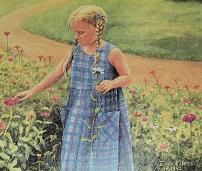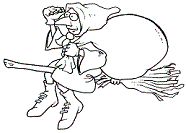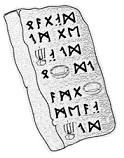|
 The following is an excerpt from the September 11th, 1954 New Yorker Magazine. It is about a Midwestern textbook publisher named Lee Greenslit, an amateur genealogist who was 68 at the time. Lee gives his opinion about the Greenslit name:
…about fifteen years ago, he ascertained that the name Greenslit was once the far more common one of Greenslade. The change came in the days of the ancestor whose fate has since caused him such distress---Ann Greenslade Pudeator. Her first husband was Thomas Greenslade, of Salem, by whom she had five children. When Greenslade died, in 1674, she was hired by Jacob Pudeator, a prosperous Salem blacksmith, to act as a nurse to his wife, who was an alcoholic. The wife died in 1675, and Pudeator married Mrs. Greenslade the following year. Six years later, Pudeator, too, died, leaving a will that provided generously for his widow. He also bequeathed small sums to his five stepchildren, and if it had not been for this kindness, Lee Greenslit today would in all probability be called Lee Greenslade, since Pudeator, who may have taken greater pains with horseshoes than he did with names, is on record as having written in his will that he wished to leave to “John Greenslit and to the other fore of my wife’s children viz., Thomas, Ruth, Samuel, and James Greenslit 5 pounds each.” Greenslit, however feels that the change could have been brought about not be Pudeator’s carelessness but by that of the town clerk who transcribed the contents of the blacksmith’s will in the official records of Salem. Proof that the children’s surname was originally Greenslade is to be found in their own father’s will, which Greenslit came upon in the Ipswich Quarterly Court Records, at Salem. Raining Cats and Dogs
I kind of like the explanation for this phrase I found on the Internet. That these animals hung out on the thatched roofs that became slippery when it rained, and then they fell off during a heavy rain. They didn't have weathermen back in the old days, just the Cat and Dog Report. But it seems it isn't true.
"Facts" About the 1500s? by Halvor Moorshead
For the last couple of years an item has been circulating around the Internet about so-called Facts about the 1500s (sometimes 1600s). A quick search using the search-engine Google pointed to over 400 websites that were carrying this piece. Interesting reading. The problem is that most of it is completely invented. The original author is not credited in any of the versions we have seen. Here we present the original version and our attempt to correct the errors.
Next time you are washing your hands and complain because the water temperature isn't just how you like it, think about how things used to be. Here are some facts about the 1500s. Most people got married in June because they took their yearly bath in May and still smelled pretty good by June. However, they were starting to smell, so brides carried a bouquet of flowers to hide the body odor. There is no evidence that June was a popular month to get married until the last 100 years. Flowers have been associated with weddings since the earliest times, probably as symbol of fertility.
More from:History Magazine 
Here is another painting by Ellen Eilers of a farm in Minnetrista Minnesota with a beautiful garden that for many years was well taken care of and besides flowers, produced a seemingly endless supply of vegetables. Oh and yes, it is a painting of someone special.

The Salem Witch Trials Memorial
"Today, visitors to Salem have the opportunity to reflect upon the tragedies of the Witch Trials of 1692 at the Witch Trial Memorial. The award-winning memorial was dedicated in 1992 by Nobel Laureate Elie Wiesel to commemorate the tercentenary of the Salem Witch Trials. Standing as a reminder of the lessons of tolerance and understanding learned from the Salem Witch Trials, the memorial creates a quiet, contemplative environment in which to evoke the spirit and strength of those people who chose to die rather than compromise their personal truths." More from: Salem.org
Fleetwood Mac - Go Your Own Way - Dance Tour '97
The band members are: Mick Fleetwood, Lindsey Buckingham, Stevie Nicks, Christine McVie, and John McVie. Buckingham's. Thank you Mick. (Click the button twice.)
Fleetwood Mac's Dreams from the Rumours tour in 1977. The band members are the same as above.
|
|
|
Origin of Witches on Broomsticks?
More from the same New Yorker Magazine article: …further research on his (Lee Greenslit's) part revealed that in the view of W. S. Nevins, and eminent nineteenth-century historian, the popular conception of witches flying around on broomsticks may be traceable to the case of Mrs. Pudeator. Nevins based his belief on two of the charges that were brought against her.  He pointed out that one of the witnesses for the prosecution, a sixteen-year-old girl named Ann Putnam, who often testified at witchcraft trials on the Salem Special Court of Oyer and Terminar, said she had seen Mrs. Pudeator “fly through the air into her house,” and that another witness, one Sam Pickworth, declared, “I was coming along Salem Street about six weeks ago when I saw a woman near Captain Higginson’s house which I supposed was Ann Pudeator, and in a moment of time she past me as swift as if a bird flew past me and I saw said woman go into Ann Pudeator’s house.” Nevins, a rather sentimental historian, wrote, “It was too bad that the woman credited with supernatural power could not fly away from her cruel fate.” Christmas Trivia
La Befana is a kindly Italian witch, who rides a broomstick down the chimney to deliver toys into the stockings of Italian children. The legends say that Befana was sweeping her floors when the three Wise Men stopped and asked her to come to see the Baby Jesus. She said that she was too busy and then later, she changed her mind but it was too late. So, the tradition says that to this day, she goes out on Christmas Eve searching for the Holy Child, leaving gifts for him in each household.

The Puritans forbade the singing of Christmas carols. The below article appeared in the Redwood Falls Gazette and talks about the Greenslit House pictured on pages one and four. It says the house was built in 1900, but I am going with the Renville County Historical Museum whose book says it was built in 1890.
April 10th, 2000
“It was a good house and served a good purpose in its last days. Maybe it will save a life.” said Harriet Deinken, owner of the large house that stood in the northwest corner of Morton.
On Saturday morning, the Morton and Franklin fire department held practice exercises inside, then burned the whole thing to the ground.
The house built in 1900 by John Freemont Greenslit, has been abandoned for the last 15 years or so and was in such shape that it would have cost more to repair than it was worth. The Deinkens donated it to the fire department to practice in.
Ironically, the burning was supervised in part by Greenslit's great grandson, John Reynolds of Hutchinson.
At its height the flames billowed 5 stories in the air, and it was so hot you couldn’t stand 60 to 70 feet from it. Firefighters had to run over and spray the Deinkens current house to keep cinders from setting it alight, and several small brush fires started in the hills to the north." Here is a Parental Consent/Medical Treatment form for sending grandchildren off to visit their grandparents: Form You can fill it in, and then print it out, but you cannot save it or email the filled out form. 
"The Norsemen had a peculiar alphabet, consisting of sixteen letters, or characters, called runes, the origin of which is lost in the remotest antiquity. The signification of the word rune (mystery) seems to allude to the fact that originally only a few were acquainted with the use of these marks, and that they were mostly applied to secret tricks, witchcrafts and enchantments. But the runes were also used in communication by writing." - from Dictionary.com Selected definitions of the word Witch from urbandictionary.com:
1) A member of the craft. One who does good deeds when and where they can, and understands the meaning of balance and spirit.
2) Someone who does their studies (Watching Charmed doesn't make you a witch, that show has its facts mixed up.)
3) Someone who does their best in this incarnate and the next.
4) Someone who knows the rules and plays by them.
5) Word used to describe someone who is particularly good at something.
Used for both genders.
Mike really helped me with my loan, he is a mortgage witch.
That was a killer sandwich, you are a witch in the kitchen.
I am reminded of the word "wizard". It can also mean, someone who is particularly good at something. I use it to compliment somebody. Pioneer Women
Here is something I found that is not too well sourced. Link to most of it: here
They lived in a one room cabin made of round logs without nails or sawed timber. Logs of the desired length were cut, with the ends being notched so as to keep them as near together as possible. A fireplace was cut out of one end of the cabin and a mud and stick chimney was built on the outside. Poles were on each side of the fireplace and a mantle over all. This was a catch all for the family, and held the tallow candle for light. Kettles were hung over the fire suspended on trammels which were held by strong poles. A long handle pan was used for cooking meat, held on the fire by hand.
The best thing for baking was a flat bottomed kettle with a tight fitting lid known as a dutch oven. With hot coals over and under the bread would bake quickly. A doorway was cut in one on the walls, and a door made of clapboards was hung on wooden hinges. This was opened by pulling a leather latchstring. If the latchstring hung outside the door it was a sign of welcome to all. The floor was made of puncheon and the boards that covered the roof were rived by hand and held up by weight poles.
The furniture of the pioneer cabin was homemade. Beds, splint-bottom chairs, a pine table, cupboard, sometimes a spinning wheel.
Neighbors were described as hospitable, and all were poor and on an equal footing. The chills and fever seemed to be the worst disease, and quinine and boneset tea were used by every family. When a whole family became ill at once the neighbors would go and take care of them. There were no matches, and fire was borrowed from a neighbor. Prairie fires were a threat in the fall to be dreaded. These fires could spread quickly and precautions had to be taken to protect the buildings and crops from being destroyed.
There were blackberries, plums and other wild fruits. Deer, wild turkey and other game were plentiful but bread stuffs were sometimes scarce. There were plenty of wild hogs. There were bees and in an early day one custom was to go bee hunting. Grandfather would travel many miles into wild country in search of the hive. He would follow the bee to his home.
Sugar taps on the maple trees provided syrup and sugar. Some families grew flax for fabric, and sheep were raised for wool. A little wheel spun the flax to finer fabrics such as dresses, and wool was spun to yarn for knitting. Fish were abundant. Herbs were for doctoring. They were gathered and dried. These herb concoctions were called tonics and administered to prevent illnesses.
Most pioneer women were pretty tough, very aggressive, and certainly of hardy stock. They were considered survivors. Today, with all our advantages, it helps to remember the hardships our ancestors endured to found this country we enjoy today. 
Witch's Hat Water Tower in Prospect Park, Minneapolis
|
|
|
|
|